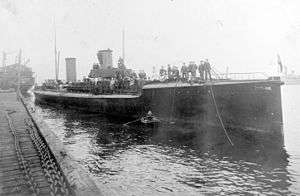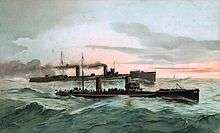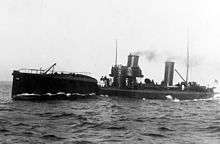S90-class torpedo boat
 S90 in Kiel, c. 1901 | |
| Class overview | |
|---|---|
| Builders: | Schichau (S), AG Vulcan (V), Germaniawerft (G) |
| Operators: |
|
| Built: | 1899—1907 |
| In commission: | 1889—1921 |
| Completed: | 48 |
| General characteristics [1] | |
| Class and type: | S90 class |
| Displacement: |
|
| Length: | 65.70 m (215 ft 7 in) o/a |
| Beam: | 7 m (23 ft) |
| Draught: | 2.63 m (8 ft 8 in) |
| Propulsion: |
|
| Speed: | 28 kn (52 km/h; 32 mph) |
| Range: | 2,000 nmi (3,700 km; 2,300 mi) at 12 knots (22 km/h; 14 mph) |
| Complement: | 2 officers, 67 enlisted |
| Armament: |
|
The S90 class of torpedo boats was a group of large torpedo boats built for the German Imperial Navy (Kaiserliche Marine) in the early 20th century. They were Hochsee-Torpedoboot ("High seas torpedo boat") built to varying designs by Germaniawerft, Schichau, and AG Vulcan. German torpedo boats were designated by shipbuilder, with the first letter of their designation reflecting their builder.[2]
Design
General characteristics and machinery

The boats of the S90 class varied in dimensions, and they gradually increased in size as more vessels were built. The boats were 62.7 to 68.5 meters (206 to 225 ft) long at the waterline and 63 to 71.5 m (207 to 235 ft) long overall. They had beam (nautical) of 7 to 7.65 m (23.0 to 25.1 ft) and a draft of 2.03 to 3.22 m (6 ft 8 in to 10 ft 7 in).[3] The hull for each boat was divided into eleven watertight compartments, though after G132, a twelfth compartment was added. They had a crew of two officers and fifty-five enlisted men, though some of the boats had larger crews; S120 had four more sailors, while G132 had twelve more men, and G131 had a crew of three officers and 78 enlisted. When serving as half-flotilla flagships, the boats would have a flotilla leader's staff of four officers and eleven enlisted men in addition to the standard crew. The vessels carried a yawl and a dinghy apiece.[4]
The S90-class boats were propelled by a pair of vertical, 3-cylinder triple expansion steam engines that drove a pair of three-bladed screw propellers. Steam was provided by three coal-fired water-tube boilers. Two boats, S125 and G137, were fitted with Parsons steam turbines instead of the older reciprocating engines; G137 also received an additional boiler. The reciprocating engine-powered boats were rated at 27 to 30 knots (50 to 56 km/h; 31 to 35 mph) from 5,900 to 7,000 indicated horsepower (4,400 to 5,200 kW). Meanwhile, S125 and G137 were rated at 6,600 shaft horsepower (4,900 kW) and 28 knots (52 km/h; 32 mph), and 10,800 shp (8,100 kW) and 30 knots (56 km/h; 35 mph), respectively. The boats had storage capacity for 93 to 168 t (92 to 165 long tons; 103 to 185 short tons) of coal. As a result, cruising radius varied significantly, from 830 to 1,500 nautical miles (1,540 to 2,780 km; 960 to 1,730 mi) at 17 knots (31 km/h; 20 mph). Each vessel was equipped with one or two 4 to 8 kilowatts (5.4 to 10.7 hp) 110-Volt generators for electrical power. Steering was controlled with a pair of rudders, one at the stern and the other in the bow.[5]
Armament
Most of the ships of the class were armed with a main battery of three 5 cm (2.0 in) SK L/40[6] guns in single pivot mounts. They were supplied with a total of 252 shells that weighed 1.75 kg (3 lb 14 oz). The guns had a muzzle velocity of 656 m/s (2,150 ft/s) and a maximum range of 6,200 yd (5,700 m) at their highest elevation of 20 degrees. G132, G133, G134, and G136 were equipped with four 5.2 cm (2 in) SK L/55 guns in single gun mounts. These guns fired a similar 1.75 kg shell at a muzzle velocity of 850 m/s (2,800 ft/s). The guns could elevate up to 20 degrees, at a maximum range of 7,100 m (7,800 yd). G135 was equipped with two of the 5.2 cm guns and one 8.8 cm (3.5 in) gun, while G137 had three 5.2 cm guns and one 8.8 cm gun. The 8.8 cm gun fired a shell weighing 7 kg (15 lb) at a muzzle velocity of 690 m/s (2,300 ft/s). The gun could be elevated to 25 degrees, for a maximum range of 8,790 m (9,610 yd). Many of the boats were rearmed throughout their time in service, trading their 5 cm or 5.2 cm guns for the more powerful 8.8 cm guns. All ships of the class carried three 45 cm (17.7 in) deck-mounted single torpedo tubes with five torpedoes.[4][7]
Ships in class



| Boat | Laid down | Launched | Commissioned | Fate |
|---|---|---|---|---|
| S90 | ||||
| S91 | ||||
| S92 | ||||
| S93 | ||||
| S94 | ||||
| S95 | ||||
| S96 | ||||
| S97 | ||||
| S98 | ||||
| S99 | ||||
| S100 | ||||
| S101 | ||||
| S102 | ||||
| S103 | ||||
| S104 | ||||
| S105 | ||||
| S106 | ||||
| S107 | ||||
| G108 | ||||
| G109 | ||||
| G110 | ||||
| G111 | ||||
| G112 | ||||
| G113 | ||||
| S114 | ||||
| S115 | ||||
| S116 | ||||
| S117 | ||||
| S118 | ||||
| S119 | ||||
| S120 | ||||
| S121 | ||||
| S122 | ||||
| S123 | ||||
| S124 | ||||
| S125 | ||||
| S126 | ||||
| S127 | ||||
| S128 | ||||
| S129 | ||||
| S130 | ||||
| S131 | ||||
| G132 | 12 May 1906 | 22 August 1906 | Broken up, 28 May 1921 | |
| G133 | 30 June 1906 | 10 December 1906 | Broken up, 28 May 1921 | |
| G134 T134 after Sept 1916 |
23 July 1906 | 6 March 1907 | Broken up, 13 May 1921 | |
| G135 | 7 September 1906 | 24 January 1907 | Broken up, 10 October 1921 | |
| G136 | 25 August 1906 | 16 March 1907 | Broken up, 20 August 1921 | |
| G137 | ||||
Service history

Footnotes
- ↑ Gröner, p. 43
- ↑ Gardiner and Gray, p. 164
- ↑ Gröner, p. 170
- 1 2 Gröner, p. 169
- ↑ Gröner, pp. 169–170
- ↑ Regarding German naval gun nomenclature, SK stands for "Schnelladekanone" (quick-loading gun) and L refers to the "Länge" (length) of the gun in terms of calibers. In the case of these guns, they were 40 calibers in length, or 40 times long as they were in diameter.
- ↑ Gardiner and Gray, p. 140
References
- Gardiner, Robert, ed. (1979). Conway's All the World's Fighting Ships: 1860–1905. London: Conway Maritime Press. ISBN 0-85177-133-5.
- Gardiner, Robert; Gray, Randal, eds. (1984). Conway's All the World's Fighting Ships: 1906-1922. Annapolis: Naval Institute Press. ISBN 0-87021-907-3.
- Gröner, Erich (1990). German Warships: 1815–1945. Annapolis: Naval Institute Press. ISBN 0-87021-790-9.